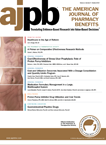Publication
Article
AJPB® Translating Evidence-Based Research Into Value-Based Decisions®
With Everything Changing, What Do I Wear?
Author(s):
Collaboration among payers, distributors, developers, clinicians, consultants, and patients is the way to succeed in managing US healthcare in the future.
Nearly every day we hear about changes or even reversals in how American healthcare will be managed in the future. Some states are voting to totally reject new legislation passed by the federal government forcing citizens to buy health coverage. I find it amazing that we do not understand the nature of a transformation of this magnitude. And the “we” to which I refer are those of us who are about to implement the gigantic new healthcare plan sometimes ever so gently referred to as “Obamacare.”
Everyone—and I mean everyone—inside and outside the healthcare business has more questions than answers about our personal and business futures under these new policies. Doctors wonder how their role will change as a variety of providers crowd them out. Hospitals work hard to stay ahead of which government plan may create draconian measures to limit reimbursements to their facility. Will length of stay, drug costs, quality assurance measures, or any number of other possibilities be used to limit hospital funding? The businesses that work to support the clinical environments wonder whether they will even get paid for what they are selling, or whether the payers can afford to pay them in the first place.
Are we prepared to work in an environment where it feels like we are walking in a fog? What happens when the rules are unclear and changing, or when we cannot see even 5 feet in front of us to know where we are going? How will our system look in 5, 10, or 20 years? Is it to become more like Canada’s healthcare system? More like Cuba’s?
I say neither one. In my view, the future is not cloudy. It is a void that is ripe for innovation and creation.
The field of technology has managed change very differently than we handle our changes in healthcare. People in technological fields cannot imagine working in a place where the future is simply a modification of the past and everyone just slides down one chair to advance the system. They work through a series of miniature and sometimes huge revolutions in development. Each new idea changes the future. This thinking creates even more opportunities as it expands possibilities for further development.
We need to move away from seeing healthcare as an evolutionary process and be open to entirely new ways of thinking. Advances in pharmaceutical development, especially biologics, happen so fast that our system will revolutionize itself, seemingly overnight. We can either be a part of it or get out of the way.
Those willing to collaborate with others in new environments will survive. We cannot afford to work any otherway. Changes now are occurring simultaneously in what medications we manufacture, how we sell them, who distributes them, and finally how the patient actually uses them. Your father’s corner pharmacy is a thing of the past.
The only way forward is through collaboration within groups such as The Pharmacy & Therapeutics Society (PTS). Together we can create new opportunities for each other. We need to work together and not apart. Our survival depends on it.
As we see how facets of healthcare such as nanotechnology, unique enzyme metabolism, and DNA evaluations are coming together, we can either be afraid or embrace these opportunities. We in the PTS see collaboration among payers, distributors, developers, clinicians, consultants, and patients as the way to succeed in going forward. As we move not to amend healthcare in the United States but to revolutionize it in every way imaginable, I must ask, “What will you wear to the Obamacare Ball?”







